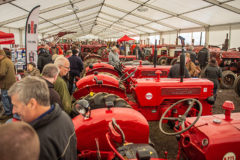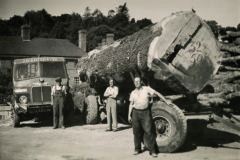Eastbourne Miniature Steam Railway
Posted by Chris Graham on 27th September 2021
David Vaughan visits the Eastbourne Miniature Steam Railway
Adventure Park to discover how one man started his own dream railway.
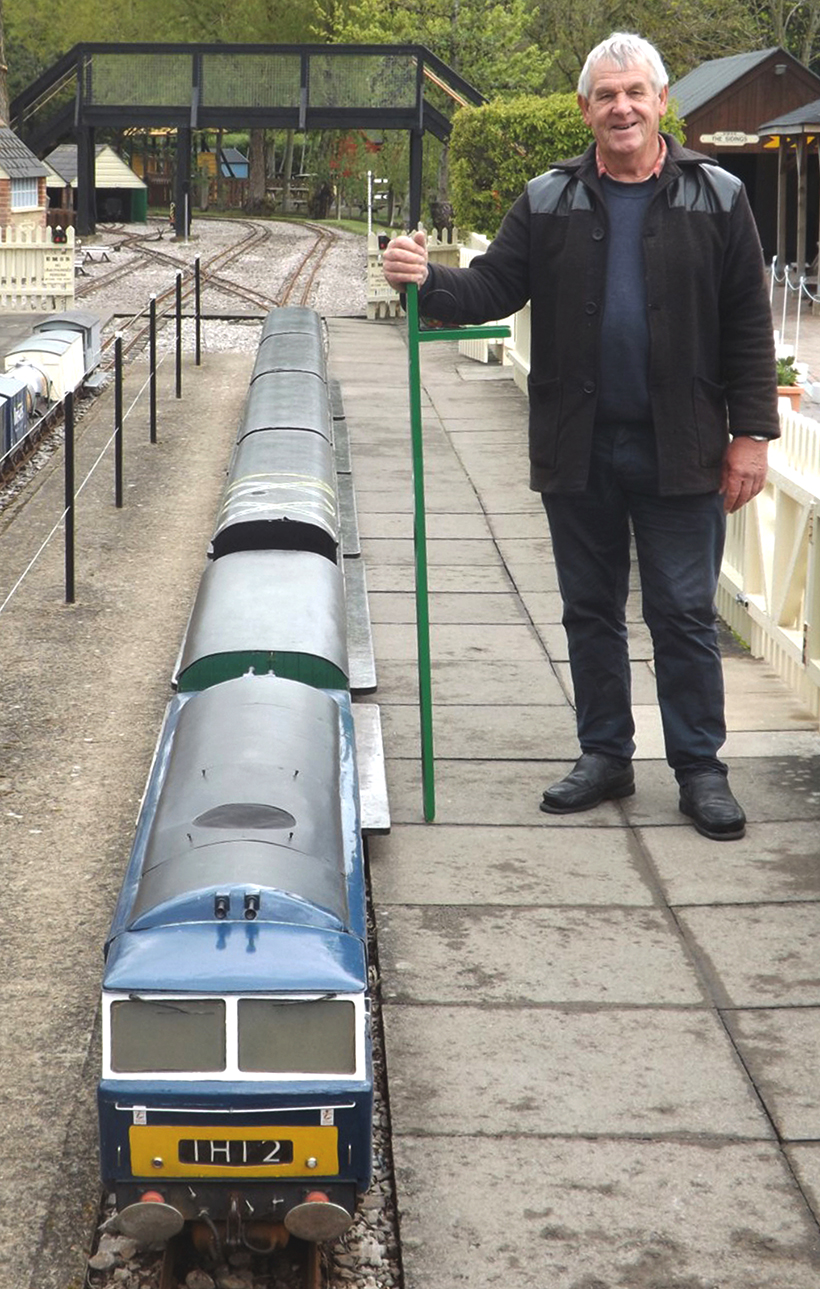
Eastbourne Miniature Steam Railway: Mike Wadey stands ready with his measuring stick on platform one at the EMSR. The stick is used to check the height of children deemed to be high enough to ride unaccompanied. Latterly it has also been used to gauge the distance between passenger groups for so-called social distancing.
David Vaughan takes a look at this highly respected 7¼in miniature railway that has served the seaside town Eastbourne so well and which so many families have enjoyed for nearly 30 years now. It’s still going strong despite the pandemic.
Back in the 1980s Mike Wadey was a full-time shift fireman with the East Sussex fire brigade stationed at Eastbourne, but when he was off-duty life centred round his family and his hobby of building and operating miniature steam locomotives. He was also a skilled engineer and built a 7¼in gauge diesel locomotive in his garden shed, soon acquiring a small steam locomotive which he and his family, wife Rachel, son Luke and daughter Cheryl, took to various club tracks around the country, all crammed into the back of the family Mini Countryman car.
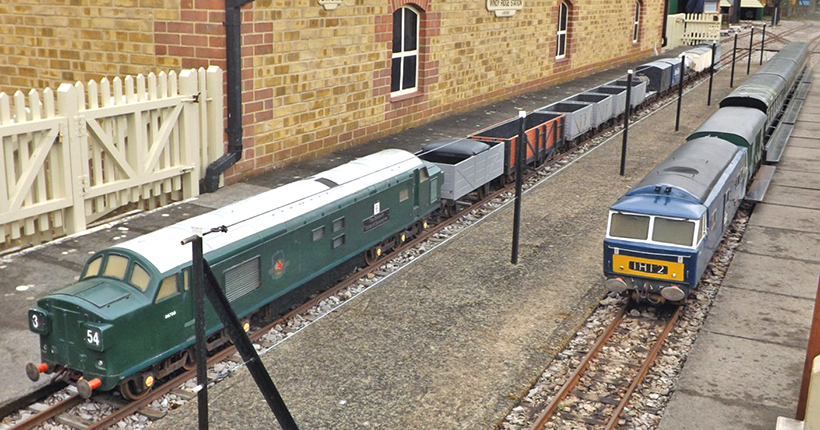
The diesels stand ready on a weekday when passenger traffic was light. The class 37 was built by Mike’s son, Luke, and is at the head of an impressive train of goods wagons, some of which were used to help build the line.
Mike also spent time at a club miniature railway near Uckfield. He set about building a larger locomotive more suited to this line and built a 7¼in scale model of a Royal Scot 4-6-0 class engine. Scaled down it might have been, but it ended up weighing in at half a ton and was over eight feet long!
All this time Mike was fired up by dreams that he might one day have a passenger-carrying railway of his own. In the summer of 1985 he heard of a plan by Eastbourne Borough Council to transform a large area of marshy land to the east of the town into ‘The Eastbourne Park,’ a massive scheme to be financed by private developers and other local entrepreneurs. The plan included a miniature railway to connect the various areas of the park including wild life areas, recreation facilities, a small golf course and lakes for water sports.
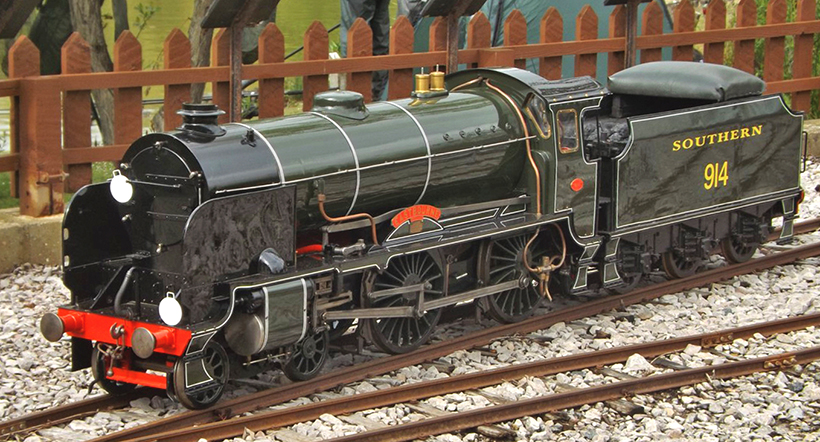
Schools class 4-4-0 Eastbourne. The full-sized locomotive this was scaled down from was named after Eastbourne college which has the original nameplate on view in its halls. The model was built by the late Les Markwick.
Mike had a meeting with the Council pointing out that their plans for the railway were largely unworkable as, among other proposed features on their track plan, the gradients would be far too steep for miniature trains. He put forward his own plan for a more modest miniature railway-themed park to cover about four acres. The land itself was under the care of the Chatsworth Estate who manage the affairs of the landowner, the Duke of Devonshire. Whilst keen on Mike’s plan they were not prepared to finance it and, as outside financial backing for the council’s scheme was not forthcoming, the original plan did not materialise as envisaged.
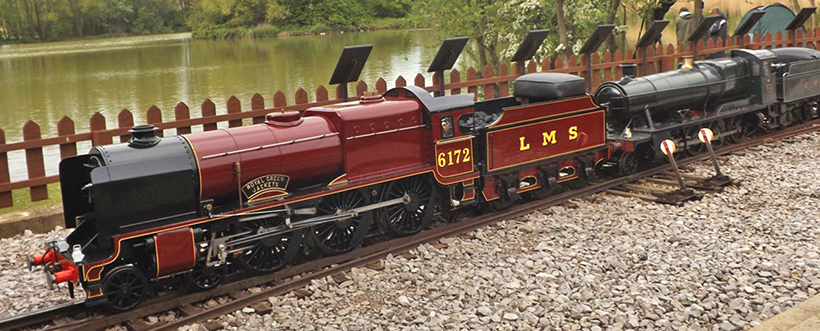
Royal Scot class Royal Green Jackets was the first steam engine built by Mike. The thought of one day running this engine on his own line fired him with the initial enthusiasm for the project. Behind it is a GWR 2000 class 2-8-0 heavy freight engine which, like its full-sized counterpart, was built in Swindon.
Not one to be easily put off, Mike continued to talk to the Chatsworth Estate who agreed to lease Mike not four acres but 25 acres! Mike and the family set about producing a new set of more ambitious plans but they had no idea just how long it would take to raise sufficient finance and jump through innumerable planning hoops including a full public enquiry. In the end the planning process took five years!
Despite applying for, and initially being granted access to several Government and tourist board grants, the financial rug was pulled from them by that body blow that has seen off many a viable scheme, Government cutbacks. The local Council agreed to dig out a proposed lake as part of the scheme in order to obtain capping material for a landfill waste site, but that was all they offered and if they were to go ahead with their plans Mike and his family would be on their own!
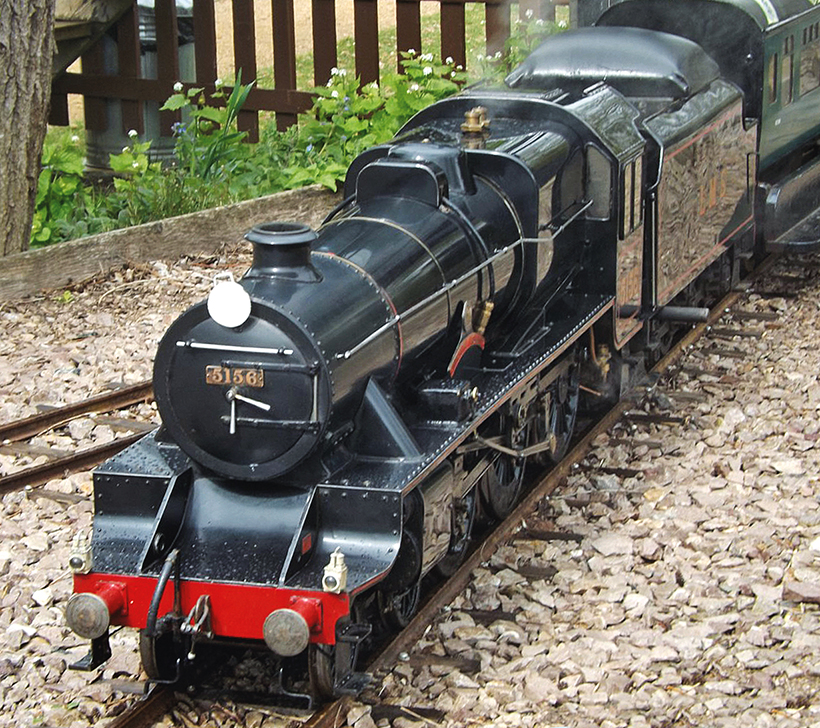
Stanier Class 5 Ayrshire Yeomanry, a reliable workhorse, was built just over 20 years ago.
At this point many a well-intentioned dream would have ended in a rude awakening, but not so that of Mike and Rachel. Support was still coming from the landowners so it was decided to bite the bullet, cut the budget as much as possible, and go ahead with the plan.
There were of course many problems to be overcome, the first of which was that the land was on the edge of Pevensey Levels, a large area of marshy land. Mike and friends soon found themselves working in a sea of gooey mud. Then came a piece of much needed good luck. A local man left a legacy bequeathed to a conservancy trust called ‘The Men of Trees,’ this was to be used to plant trees as part of a local amenity. They chose Mike’s scheme and set about planting 6,000 saplings. Not only did this add beauty to an otherwise barren landscape but it also would help to stabilise the soil and soak up water.
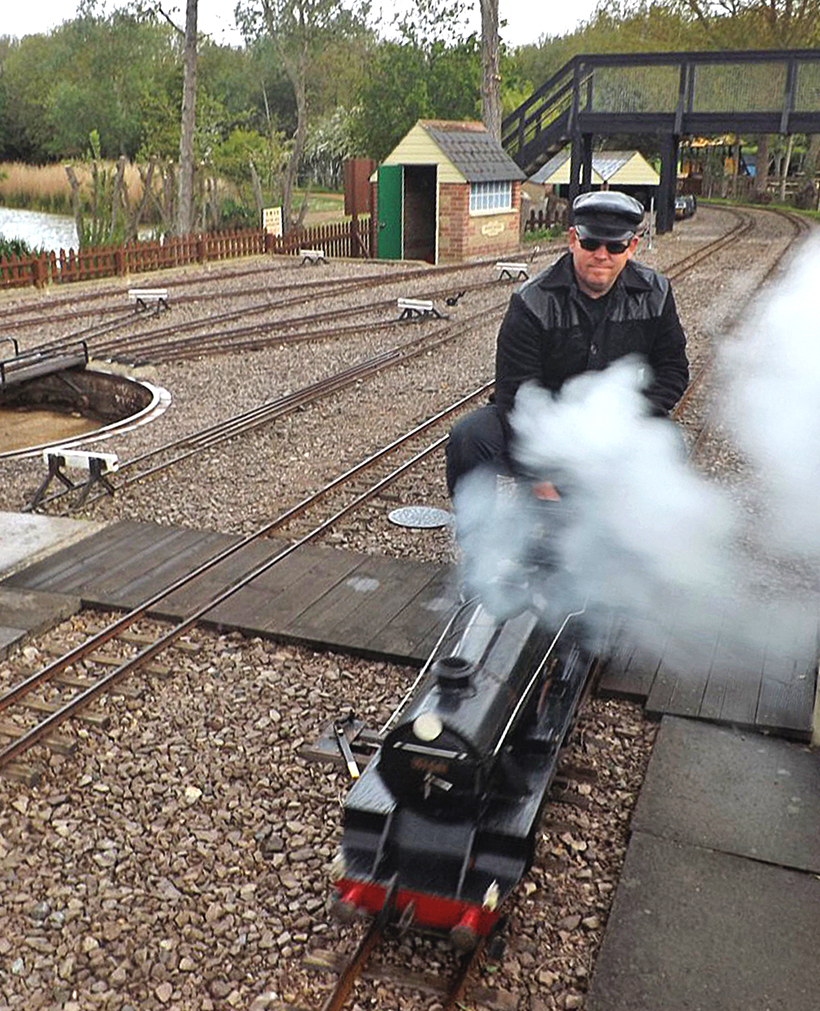
Luke brings Ayrshire Yeomanry off shed ready for a day’s duties on the line.
Work on the site started in earnest at Easter in 1991 and an ambitious opening date was set for the following Easter. Mike had help from a good friend Dave Padgham who arranged for hundreds of tons of soil and hardcore from a local demolition site to be delivered, paid for by contractors needing a suitable local dumping site. Dave also supplied and operated an excavator and other plant for the groundwork and main services to be laid in.
Despite this, and a lot of forward planning, there was still a mountain of work to climb and almost all of it was done by Mike himself working tirelessly side-by-side with his wife Rachel and, when they were available after school, his two children. Mike was still working as a full-time shift fireman for the local brigade and he and the family were also putting in up to 14 hours a day on the railway.
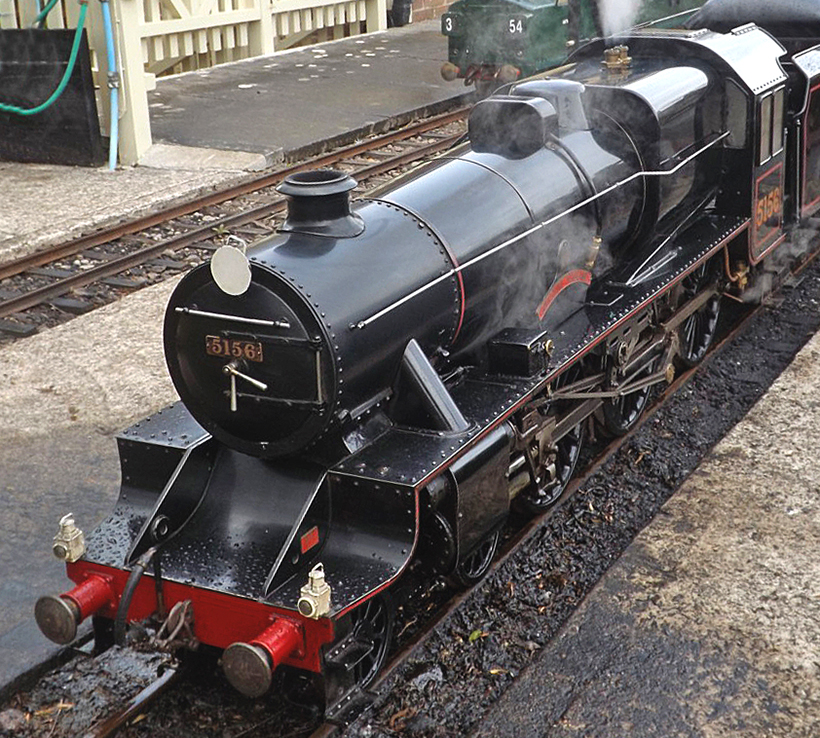
The Black 5 stands with steam up ready for the first train of the day.
Work went on throughout the winter of 1991/92 in typical English weather and with many a problem to be overcome. Mike and family, along with all the other jobs, constructed nearly a mile of track work using 4 tons of steel, 2 miles of timber for the sleepers, 200 tons of ballast and thousands of fixing bolts. This was all done on site where, by now, the family was living in their erstwhile touring caravan.
Slowly but surely the buildings took shape, starting with an impressive engine shed and then a café and gift shop. The weekend of Easter 1992 was coming ever closer and it was touch and go that all would be ready in time. In fact the last length of track was not laid until the day before opening after working nearly all night making the last few sections. Next morning saw Mike and Luke putting in the last section of track in the rain and there was just time for a test train or two with Mike’s Royal Scot loco to iron out any uneven ballasting. Not having dared to put out much in the way of advance publicity lest the opening had to be put back, Mike and family were pleasantly surprised when 80 passengers turned up to ride on the first official trains.
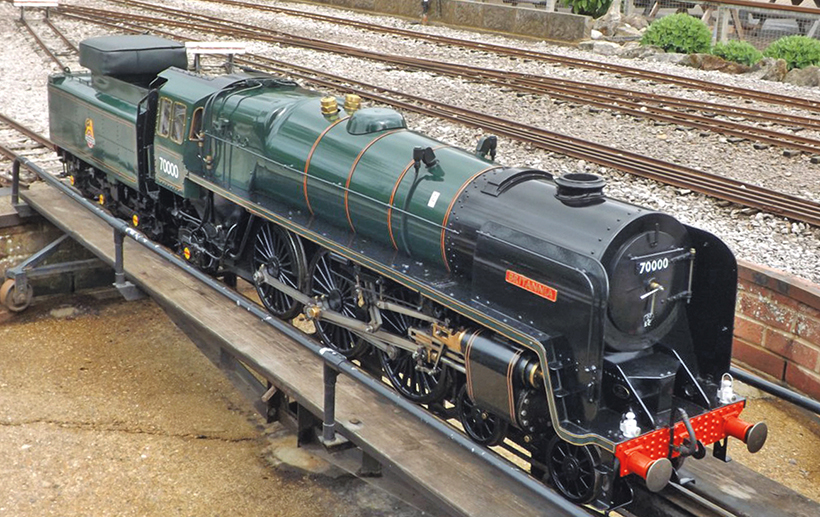
This 7¼-inch scale model of Britannia, a BR Standard class 7 express passenger engine, is an impressive locomotive in any scale. This one was built by Luke Wadey.
The line stayed open for the Easter holidays but a date of 26 May 1992 was set for the official opening by The Marquess of Hartington, owner of the land, and representatives of the Borough Council and the press. That occasion went very well and everyone involved could see that a pipe dream had become reality at last.
I went to see Mike the following year to write an article for a local magazine and was very impressed with the line and its surroundings and Mike explained to me then his proposals for further development of the railway and its surrounding parkland. Next year will mark 30 years since the line was opened, and when I visited in May of this year, I was amazed at the way it had been developed from a muddy and featureless marsh into a rather beautiful parkland area that could be enjoyed by all age groups, a pleasant place to walk or watch the trains go by and a wonderful resource for nature, with thousands of mature trees and shrubs. It is situated in a part of Eastbourne’s so called ‘Green Lung,’ an area of open space that reaches into the heart of the famous Sussex resort and, thankfully so far, protected from building development, in fact adjoining the park is an area of original marshland with grazing cattle still on it.
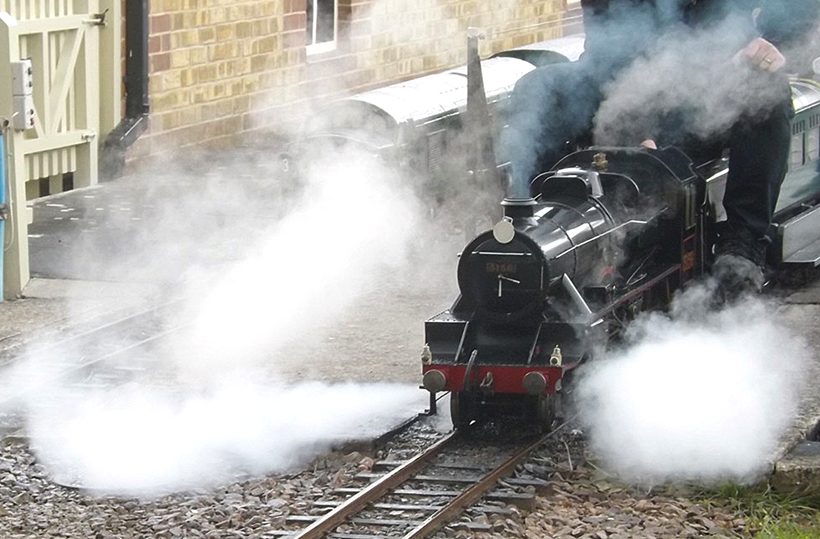
With Luke Wadey in the driver’s seat, Ayrshire Yeomanry blows down the drain cocks and is away on the first run on a rainy Sunday morning in May.
The railway has built up an impressive array of 7¼in gauge locomotives and rolling stock. The first locomotive was Mike’s own Royal Scot 4-6-0 class Royal Green Jackets. This was followed by two engines built by Hastings based engineer Les Markwick, an LMS 4F 0-6-0 and a superb model of a three-cylinder SR Schools class 4-4-0 locomotive Eastbourne, the original nameplate of which adorns the walls of the local private school after which the full-sized engine was named.
Mike acquired a GWR 2-8-0 heavy freight loco, built in 1990, by a Mr Newbury based, appropriately, in Swindon and also a Stanier ‘Black 5’ 2-6-0. My personal favourite is however the replica of Britannia, the Riddles-designed BR Standard Class 7 4-6-2 Pacific express engine built by Mike’s son Luke. The seventh locomotive in the fleet is actually the oldest, being originally built in the 1940s and is a replica LNER Flying Scotsman A1 4-6-2 Pacific.

Luke Wadey drives the Hymec with a short passenger train. The building to the left, called ‘The Sidings’, contains three of the four model coin-operated railway layouts on site. The model diesel was built originally for Mike’s garden railway, and is a petrol-electric hybrid – so nothing’s new, then!
Diesels are not forgotten either, with a BR Western Region Hymek built by Mike for his original garden railway, and a Class 37 diesel built by Luke. Both are used as relief engines and are appreciated by younger visitors who have never seen steam on the mainline in daily use. There is also a Class 08 0-6-0 diesel shunter, which is used for moving empty stock around the sidings.
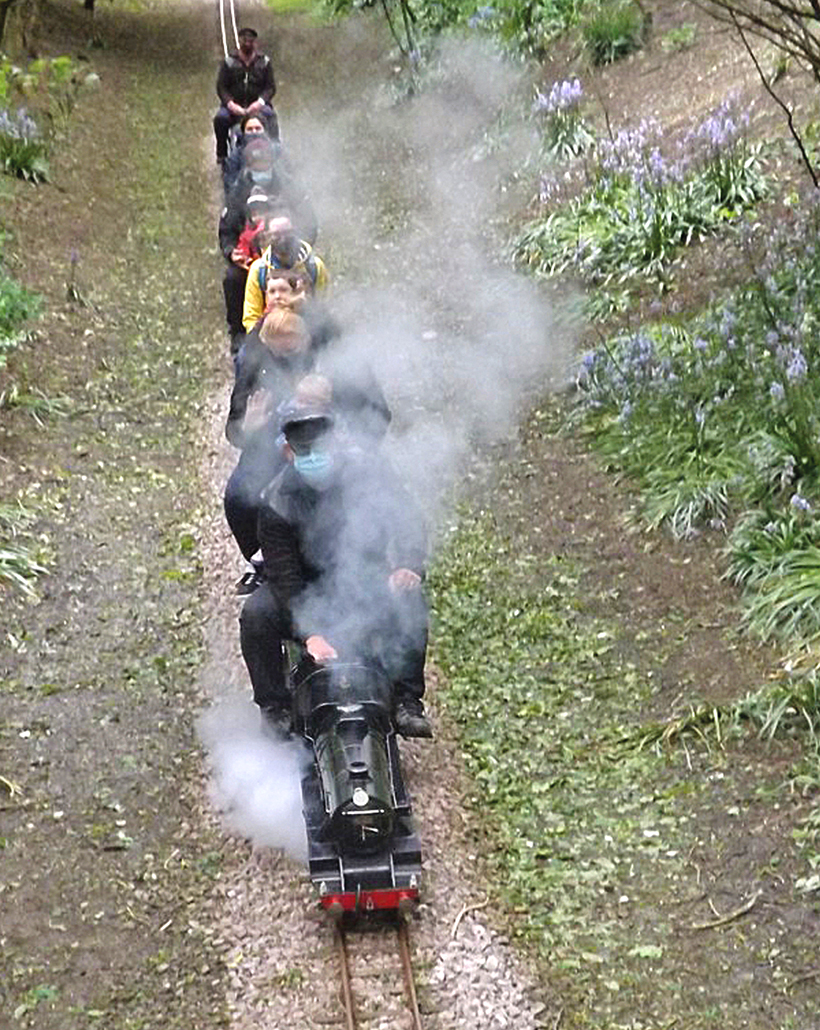
The line was built on marshland, but has undergone extensive landscaping including bridges, a tunnel, and this cutting, sporting a spring display of bluebells.
The line is signalled by a series of computer-controlled colour light signals and other safety devices and could, in theory, run up to eight trains at once, but normal service is two trains plus a third in times of heavy demand. During the summer season the railway can enjoy receiving up to around 700 visitors on a busy day.
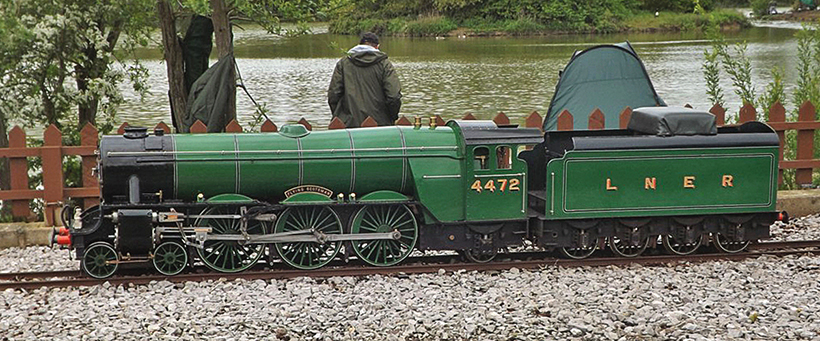
This scaled-down Flying Scotsman A1 class locomotive is the oldest on the line, having been by an unknown builder in the 1940s.
Of course during the last 14 months the railway has been unable to operate as normal due to the Covid lockdown restrictions. As a commercial undertaking, the income from which Mike and his family and 22 full or part-time employees relied upon has been severely affected. This to say nothing of the knock-on effects of the epidemic on the economy of the town of Eastbourne, which is reliant upon tourism for its main income. Mike has relied upon help from the government’s furlough scheme to keep his staff on the payroll, and business rates have been frozen, but the rent to the Chatsworth estate’s agents, as well as continuing payments for services such as electricity and water, have had to be paid despite having no income.
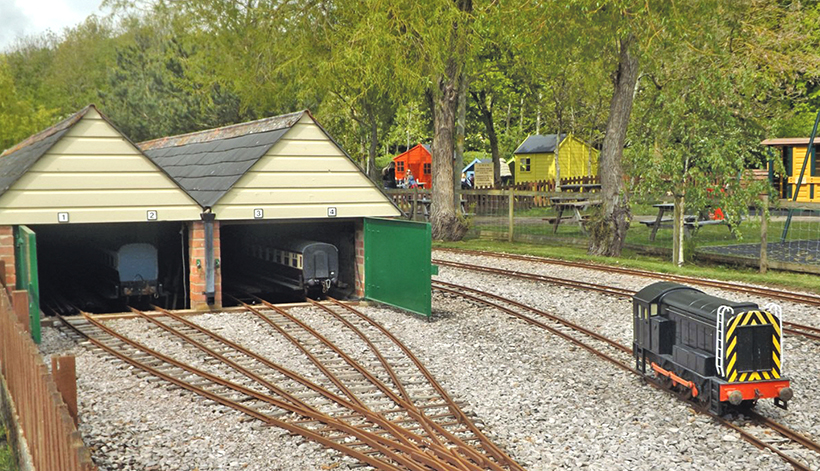
The line’s shunter, a class 08 diesel, stands outside the engine shed which features a space-saving, four-way stud point built on site.
There was a short period between July and September when the railway was able to open under severe social distancing restrictions but, as we all know, this was followed by another spike in national infections resulting in a further period of total lockdown. As a result Mike has had to dig into his capital reserves, which puts future development plans on hold. However Mike is not a man to let things, even pandemics, stand in his way and was running a limited service when I visited in May with parties of very happy children and families enjoying a rare sunny day out shortly after lockdown restrictions were partially lifted.
The family-run business is very much looking forward to 21 June when, as things stand, most if not all restrictions will be lifted and the railway can get back to doing its job of giving children and families an enjoyable day out. As for Mike, Rachel, Luke, and Cheryl, they are still enjoying living and working with the dream that they were instrumental in creating and Mike is of course still fired up with a love of everything steam!
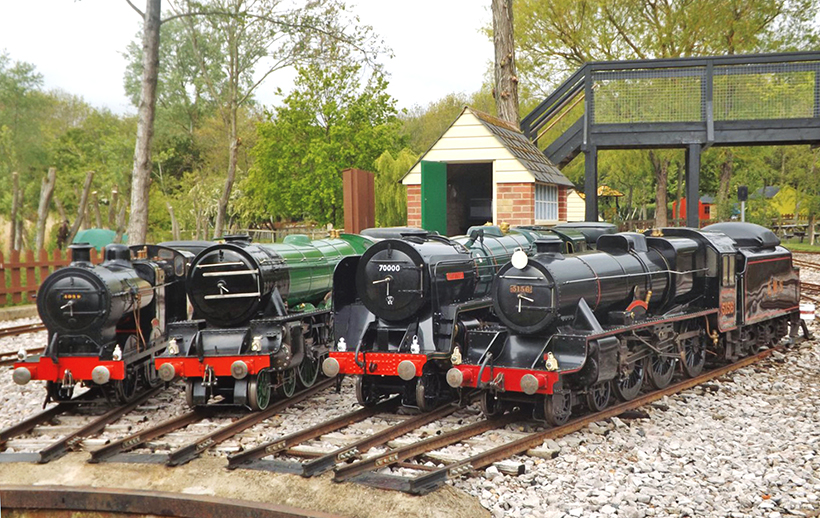
A line up of EMSR motive power on the turntable roads. Left to right; LMS class 4P 0-6-0 named Rachel, after Mike’s wife who was his stalwart co-worker when building the line. Next is Flying Scotsman and then Britannia. Nearest the camera is the Stanier Black 5 Ayrshire Yeomanry.
If you want to read more about this interesting and enterprising miniature steam railway then I can recommend Mike’s book Between the Fires which details the trials of setting up and running the railway in a humorous and entertaining manner, priced at £4.99 and available from EMSR’s railway gift shop. Full details of the railway, how to get there, and its 2021 timetable are available at www.emsr.co.uk.
For a money-saving subscription to Old Glory magazine, simply click here



